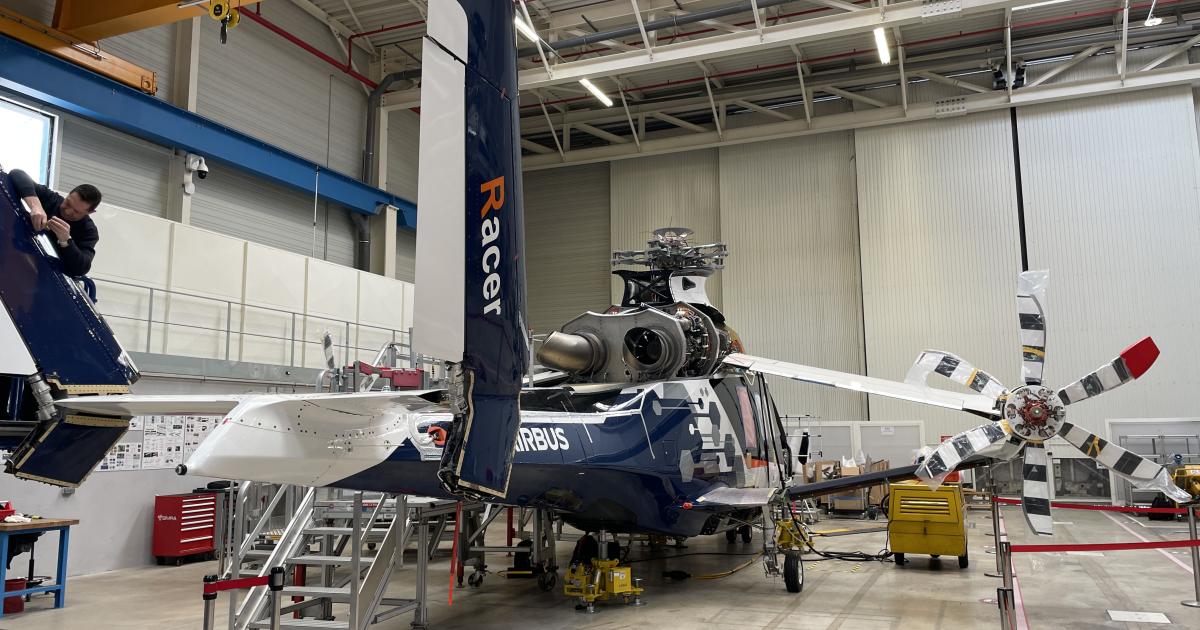Vel, ikke den samme maskinen, men den samme konstruksjonen. Orginalen står i museet på Le Bourget. Den har den uoffisielle hastighetsrekord i level flight på 255 kts. Tilt rotor er en annen kategori hvor V-22 har rekorden.
Foto: Airbus Helicopters
(Red.)
Airbus Set To Start Racer High-speed Flight Trials

Airbus Helicopters is preparing to start flight testing with its Racer high-speed rotorcraft technology demonstrator in late March. Engineers at the company’s Marignane headquarters in France are now completing the installation and testing of all subsystems as they prepare to start the next phase of the program to define the configuration of a new-generation helicopter featuring rear-facing propellers in addition to a main rotor.
In 2013, Airbus achieved an unprecedented speed of 255 knots with its earlier X3 demonstrator, and now the company is looking to define what it can also deliver in terms of payload and range. “Our objective now is to get closer to an operational configuration, and also closer to what could be certified,” Racer program manager Julien Guitton told reporters during a media briefing on February 13. “We want to achieve the best possible compromise between cost, environment, and performance.”
Accordingly, the Racer flight trials are expected to target a top speed of 220 knots, which Airbus feels will represent the most efficient use of Racer’s hybrid-electric powertrain developed by Safran. Operating at 180 knots, it is expected to burn 15 percent less fuel than a conventional helicopter at 130 knots. Using the so-called Eco-Mode, one of the two Aneto-1X engines can be switched to standby during cruise flight to increase fuel savings to 30 percent.
According to Racer’s chief engineer, Brice Makinadjian, Airbus and its partners have taken multiple design options to reduce drag by around 25 percent. These include a new fairing design, narrowing the fuselage while not reducing the size of the cabin, an asymmetrical tail boom, and a box wing featuring an integrated landing gear. By having two smaller wings, there should be less downwash from the rotors, making for more efficient hover performance.
Airbus is also looking to achieve lower noise levels during approach and takeoff by adjusting the attitude and speed of the aircraft with pre-set autopilot commands. “This means we can control the trajectory of the disk blade vortex and also by deploying flaps on the wing,” Makinadjian explained.
As it continues to prepare the way for a new high-speed helicopter, Airbus is aiming to achieve a high degree of system commonality with conventional aircraft in order to reduce costs. This could see it deploy the same gearbox, tail rotor, and avionics for future models.
The Racer is expected to log around 200 flight hours over the course of a two-year demonstration program. The first flight will mark the end of the European Union-backed CleanSky 2 program that has involved 40 partners from 13 countries.
“This will be the real start of the Racer program," Guitton said. “First we will open up the envelope and explore the maximum speed, and then we will focus on payload, range, and maneuverability.”
Airbus is planning to demonstrate various civil and parapublic missions that could include emergency medical support. It is also in discussions over possible military applications.




Ingen kommentarer:
Legg inn en kommentar
Merk: Bare medlemmer av denne bloggen kan legge inn en kommentar.